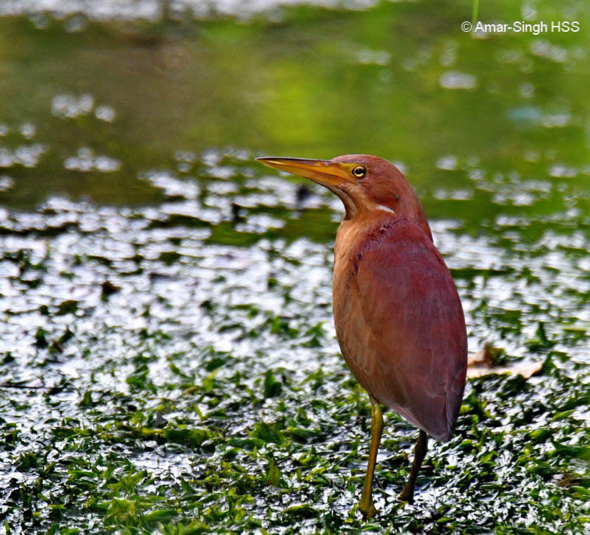
“Over the past 45 years that I have been bird watching I have seen the gradual and progressive decline of the Cinnamon Bittern (Ixobrychus cinnamomeus) in my region. When I was younger this was the commonest bittern I would encounter. I would see it easily and often whenever I was in a wetlands area, especially in ex-mining pools that has Water Lilies.

“I spent considerable time watching it feed; the consummate fisherman. The experience of other bird watchers from the past is as below:
1. Robinson & Chasen (1927-1939) in volume 3 & 4 of ‘Birds of Malay Peninsula Vol. 1-4’ says of the Cinnamon Bittern ‘A common resident in the neighbourhood of rice fields and the thick vegetation bordering rivers, etc.’ and ‘Abundant on Singapore Island many years ago, but scarcer now, as it has been much persecuted by Chinese shooters’. While the Yellow Bittern was considered ‘largely, a winter visitor from the north’.
2. Madoc GC (1947) in ‘An Introduction to Malayan Birds. Malayan Nature Society’ principally describes the Cinnamon Bittern and states: ‘This common Bittern is an inhabitant of rice-fields and fresh water swamps.’ The only other Bittern that Madoc chooses to describe is the Yellow Bittern but it was not as common.
3. Tweedie MWF (1970) in ‘Common Birds of the Malay Peninsula. Longman’ also only describes the Cinnamon Bittern and states ‘This is the only species of Bittern that is common in the region …’
4. Glenister AG (1971) in ‘The birds of the Malay Peninsula, Singapore and Penang. Oxford University Press’ describes all the bitterns but suggests the Cinnamon Bittern is a common resident and the Yellow Bittern is a visitor.
5. Wells DR (1999) in ‘The birds of the Thai-Malay Peninsula: Vol. 1 (Non-Passarines). Christopher Helm, London’ describes the Cinnamon Bittern as ‘…easily the most numerous Ixobrychus bittern overall, matched only locally by Yellow Bittern’.
“I quote these 5 sources to suggest that my experience was the same; the Cinnamon Bittern was common and the Yellow Bittern (Ixobrychus sinensis) less often seen. Today the predominant bittern I encounter in wetlands in my region is the Yellow Bittern; it is easily and often seen. The Cinnamon Bittern is uncommon and requires patience to find. Some images of a resident male I saw today (part of a pair) in the posts.
“Why has the Cinnamon Bittern declined in my region?

“Some possibilities include:
1. Is the Cinnamon Bittern being hunted? Martínez-Vilalta, Motis & Kirwan (2018) on the ‘Cinnamon Bittern (Ixobrychus cinnamomeus)’ in Handbook of the Birds of the World Alive quotes ‘Kushlan & 2005. The Herons. Oxford University Press’ to say that although ‘most populations appear to be quite healthy’ there is ‘some local hunting (e.g. in Malaysia‘. I have not seen much hunting in recent years but poachers do exist and the huge influx of a poorer foreign labour force has meant that some wild birds are caught for food. But this should affect all the bitterns equally.
2. Could the Cinnamon Bittern be seen less often than the Yellow Bittern due to behaviour (more shy and secretive)? I have watched both birds over many years and do not find much difference in their ‘desire’ to hide from humans.
3. Could the Yellow Bittern be replacing the Cinnamon Bittern in its habitat i.e. competitive breeding? The Yellow Bittern was described as, up to early 1980s, nesting only as far south as Penang (Wells 1999). Soon after, found much further south in Peninsular Malaysia and Singapore. It is possible that this rapid spread south has displaced the Cinnamon Bittern.
4. A final possibility is that perhaps my observations are limited i.e. localised or apply only to Perak. Others may have more frequent observations of the Cinnamon Bittern elsewhere in the Peninsular. I would be delighted to hear about this.”
Dato’ Dr Amar-Singh HSS
Ipoh, Perak, Malaysia
28th April 2018
Location: Ipoh, Perak, Malaysia
Habitat: Over grown ‘monsoon drains’ in the city









One Response
I have spotted a male Cinnamon Bittern on my farm in Chiang Mai, Thailand in mid June 2019 on several days. It appears to have made a home amongst the ferns. This is the first time I have spotted a Cinnamon Bittern on my farm. As of 15 June 2019 I have not seen a female. William.